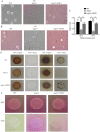HOG1 has an essential role in the stress response, virulence and pathogenicity of Cryptococcus gattii
- PMID: 33767771
- PMCID: PMC7976431
- DOI: 10.3892/etm.2021.9907
HOG1 has an essential role in the stress response, virulence and pathogenicity of Cryptococcus gattii
Abstract
Cryptococcus gattii (C. gattii) is a lethal pathogen that causes the majority of cryptococcosis cases in previously healthy individuals. This pathogen poses an increasing threat to global public health, but the mechanisms underlying the pathogenesis have remained to be fully elucidated. In the present study, the role of high-osmolarity glycerol (HOG)1 in the stress reaction and virulence control of C. gattii was characterized by deleting the HOG1 gene using the clinical isolate strain CZ2012, and finally, the virulence and pathogenic traits of the deletion strain were defined. Deletion of the HOG1 gene resulted in notable growth defects under stress conditions (high salt and antifungal drugs), but different traits were observed under oxidative stress conditions (hydrogen peroxide). Similarly, the C. gattii hog1Δ strains (deletion of HOG1) also displayed decreased capsule production and melanin synthesis. Furthermore, mice infected with the hog1Δ strain had longer survival times than those infected with the wild-type strain and the reconstituted strain. The hog1Δ strain recovered from infected organs exhibited significant growth defects in terms of decreased colony count and size. The present results suggested that HOG1 has a significant role in the virulence of C. gattii and these results may help to elucidate the pathogenesis of C. gattii.
Keywords: Cryptococcus gattii; high-osmolarity glycerol 1; pathogenicity; stress response; virulence.
Copyright: © Huang et al.
Conflict of interest statement
The authors declare that they have no competing interests.
Figures




Similar articles
-
Hrk1 plays both Hog1-dependent and -independent roles in controlling stress response and antifungal drug resistance in Cryptococcus neoformans.PLoS One. 2011 Apr 13;6(4):e18769. doi: 10.1371/journal.pone.0018769. PLoS One. 2011. PMID: 21533251 Free PMC article.
-
Deubiquitinase Ubp5 Is Required for the Growth and Pathogenicity of Cryptococcus gattii.PLoS One. 2016 Apr 6;11(4):e0153219. doi: 10.1371/journal.pone.0153219. eCollection 2016. PLoS One. 2016. PMID: 27049762 Free PMC article.
-
Chitosan Biosynthesis and Virulence in the Human Fungal Pathogen Cryptococcus gattii.mSphere. 2019 Oct 9;4(5):e00644-19. doi: 10.1128/mSphere.00644-19. mSphere. 2019. PMID: 31597720 Free PMC article.
-
[Mechanism of Cryptococcus Meningoencephalitis].Med Mycol J. 2016;57(1):J27-32. doi: 10.3314/mmj.57.J27. Med Mycol J. 2016. PMID: 26936349 Review. Japanese.
-
Environmental prevalence of Cryptococcus neoformans and Cryptococcus gattii in India: an update.Crit Rev Microbiol. 2012 Feb;38(1):1-16. doi: 10.3109/1040841X.2011.606426. Epub 2011 Dec 1. Crit Rev Microbiol. 2012. PMID: 22133016 Review.
Cited by
-
The emerging fungal pathogen Cryptococcus gattii: Epidemiology, pathogenesis, immunomodulatory attributes, and drug susceptibility.PLoS Negl Trop Dis. 2025 Jul 3;19(7):e0013245. doi: 10.1371/journal.pntd.0013245. eCollection 2025 Jul. PLoS Negl Trop Dis. 2025. PMID: 40608829 Free PMC article. Review.
-
Cell Wall Integrity Pathway Involved in Morphogenesis, Virulence and Antifungal Susceptibility in Cryptococcus neoformans.J Fungi (Basel). 2021 Oct 5;7(10):831. doi: 10.3390/jof7100831. J Fungi (Basel). 2021. PMID: 34682253 Free PMC article. Review.
-
Oxidative stress response pathways in fungi.Cell Mol Life Sci. 2022 Jun 1;79(6):333. doi: 10.1007/s00018-022-04353-8. Cell Mol Life Sci. 2022. PMID: 35648225 Free PMC article. Review.
-
Resilience in Resistance: The Role of Cell Wall Integrity in Multidrug-Resistant Candida.J Fungi (Basel). 2025 Apr 1;11(4):271. doi: 10.3390/jof11040271. J Fungi (Basel). 2025. PMID: 40278091 Free PMC article. Review.
-
What's New in Cryptococcus gattii: From Bench to Bedside and Beyond.J Fungi (Basel). 2022 Dec 27;9(1):41. doi: 10.3390/jof9010041. J Fungi (Basel). 2022. PMID: 36675862 Free PMC article. Review.
References
-
- Heitman J. American Society for Microbiology. (2011). ‘Cryptococcus: From human pathogen to model yeast.’ Washington, DC, ASM Press.
-
- Pakshir K, Fakhim H, Vaezi A, Meis JF, Mahmoodi M, Zomorodian K, Javidnia J, Ansari S, Hagen F, Badali H. Molecular epidemiology of environmental Cryptococcus species isolates based on amplified fragment length polymorphism. J Mycol Med. 2018;28:599–605. doi: 10.1016/j.mycmed.2018.09.005. - DOI - PubMed
-
- Bandalizadeh Z, Shokohi T, Badali H, Abastabar M, Babamahmoudi F, Davoodi L, Mardani M, Javanian M, Cheraghmakani H, Sepidgar AA, et al. Molecular epidemiology and antifungal susceptibility profiles of clinical Cryptococcus neoformans/Cryptococcus gattii species complex. J Med Microbiol. 2020;69:72–81. doi: 10.1099/jmm.0.001101. - DOI - PMC - PubMed
LinkOut - more resources
Full Text Sources
Other Literature Sources
